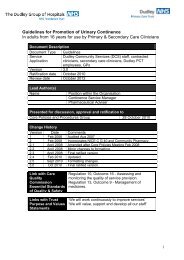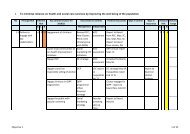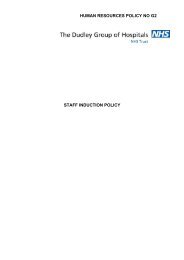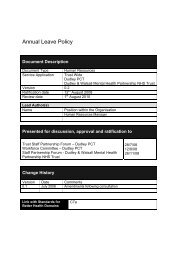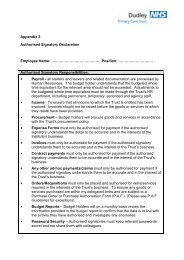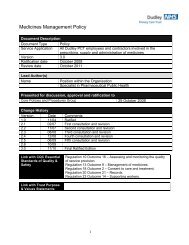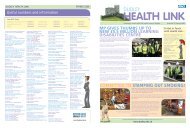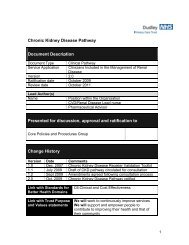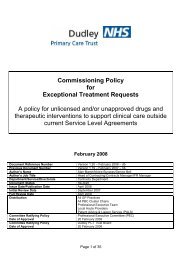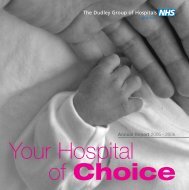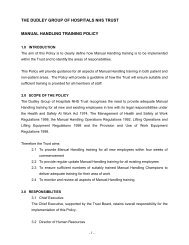Dudley Strategy for Tackling Health Inequalities 2010-15
Dudley Strategy for Tackling Health Inequalities 2010-15
Dudley Strategy for Tackling Health Inequalities 2010-15
- No tags were found...
Create successful ePaper yourself
Turn your PDF publications into a flip-book with our unique Google optimized e-Paper software.
Key findings from analysis of mortality data using the ICE matrixOverall mortality rates due to accidents, suicides and undetermined injury arehigher in males than females. Mortality rates have declined over time andcontinue to do so <strong>for</strong> suicides and undetermined injury, whereas <strong>for</strong> accidentsthere has been an upturn since 2000 and rates <strong>for</strong> <strong>Dudley</strong> are again similar tothose <strong>for</strong> England and Wales.There is a health inequalities gradient <strong>for</strong> mortality from external causes(higher rates in the most deprived areas) and this is worse <strong>for</strong> males.The rise in mortality rates <strong>for</strong> accidents over the last 10 years is mostapparent in the over 75 age band with the main mechanism being falls andfractures. In males there has been little change over time in mortality ratesfrom accidents <strong>for</strong> the <strong>15</strong>-54 age band, whereas it has declined <strong>for</strong> females.This is true also <strong>for</strong> this age band with mortality rates from suicide andundetermined injury.In 2004-2008 falls and fractures were the most common mechanism of injurymortality, followed by poisoning and transport. The move in emphasis awayfrom transport as the main mechanism is due to a real decline in trafficaccidents and to the inclusion of deaths from drug abuse/dependence withdeaths from poisoning and deaths from osteoporosis and fracture withexternal cause unspecified with deaths from falls.There has been an increase in the death rates <strong>for</strong> drug abuse/dependenceand homicide rates in males since 1994-1998.In terms of deprivation the main mechanisms which show a negative socialgradient are poisoning (particularly ages <strong>15</strong>-54 and 75+ <strong>for</strong> males and age 35-74 <strong>for</strong> females), transport <strong>for</strong> males where the negative gradient is prominentin the <strong>15</strong>-34 age band, suffocation which shows a negative gradient overall <strong>for</strong>males and females and this is emphasised in the under 75 age <strong>for</strong> males andthe under 35 age band <strong>for</strong> females. Falls and fractures showed no overallsocial gradient <strong>for</strong> males and showed a positive gradient <strong>for</strong> females over 75,but a negative gradient <strong>for</strong> the younger age bands.Hospital Admissions from external causesFigures 10-11 show the trend in hospital admissions from accidents and suicidesand unintentional injuries <strong>for</strong> <strong>Dudley</strong>. For accidents the directly standardisedemergency hospital admission rates in <strong>Dudley</strong> over the last 6 years have been risingand are significantly higher <strong>for</strong> men than women. Directly standardised emergencyhospital admission rates <strong>for</strong> suicides and undetermined injury have increased overthe last 6 years and this has been at a faster rate <strong>for</strong> females and hence admissionrates are higher <strong>for</strong> females than males. There is a strong gradient of deprivation <strong>for</strong>emergency hospital admissions from both accidents and suicide and undeterminedinjuries particularly <strong>for</strong> men <strong>for</strong> accidents and <strong>for</strong> both sexes <strong>for</strong> suicide andundetermined injury as shown in Figures 12 and 13 respectively. To furtherunderstand the data it has been analysed using the International Collaborative Ef<strong>for</strong>t(ICE) on injury statistics matrix.165




